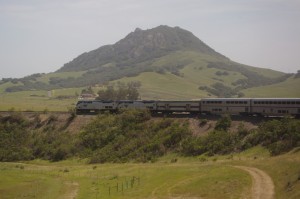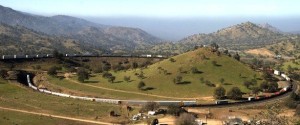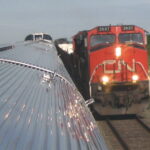Straightaways Are Fine, But Real Rail Fans Prefer the Big, Slow Curves.
Train travel enthusiasts and ordinary passengers alike all seem to get excited when it comes to horseshoe curves. When a train – whether passenger or freight – starts circling through one of them, cameras come out and people inside the train and outside at trackside start snapping away.
There’s a wonderful horseshoe curve just a few miles north of San Luis Obispo in California. Every time I approach it on the southbound Coast Starlight, I grab my camera and head to the rear coach to get the classic shot of the locomotive and the first four or five cars a hundred yards or so away and heading in the opposite direction from mine at that moment. I‘ve taken that photo at least a dozen times over the years, which means I probably have 40 or 50 shots that are almost identical to the one above.
Every so often, passengers on the Coast Starlight really score. This Saturday, September 14th, there’s going to be a lot of track work on its normal route so the train will be diverted and head north by way of the Tehachapi Loop. Rail fans who just happened to have booked the train on that day are ecstatic because those are the only circumstances when passenger trains are sent that way anymore.
But, as you can see, the Tehachapi Loop is much more than just an “ordinary” horseshow curve; this is a full 360-degree circle designed to allow the northbound trains to gain elevation for its passage over 4,000-foot Tehachapi Pass.
There are several other horseshoe curves in North America and no doubt the best known is near Altoona, Pennsylvania. How famous is it? Well, there’s a minor league baseball team in that town. They’re known as the Altoona Curve.





After years of wanting to go, I finally made the 5 hour drive to Altoona this weekend to see Horseshoe Curve and the other railroad sites in the area. There was a near constant parade of trains around the curve and I had a great time. Even my wife thought it was interesting and enjoyable!